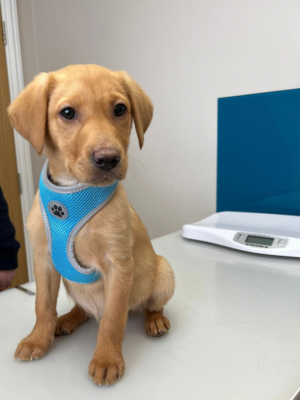Diabetes in Dogs
What is diabetes?
Diabetes mellitus is when the body does not produce enough insulin, the hormone that stabilises your blood glucose levels. Low insulin leads to high glucose levels in the blood known as hyperglycaemia. The glucose is therefore not encouraged to go into your cells where it is essential for fuelling metabolism and effectively the cells become starved of energy. It affects about 1 in 300 dogs and can affect dogs between the ages of 4 and 14 years old. Some breeds are more commonly affected.
What are the symptoms?
- Drinking a lot
- Urinating a lot
- More hungry than usual
- Weight loss
- Less active or sleeping more
- Frequent infections
- Cataracts (clouding of the lens of the eye)
- Ketoacidosis usually resulting in symptoms such as vomiting, inappetence and lethargy
Diagnosis
We can diagnose diabetes through a combination of blood and urine tests. In house blood tests will show high glucose levels, with urine tests documenting glucose and sometimes ketones. If these are high, we will send a sample to the external laboratory to look at a blood level called fructosamine. This is a marker that demonstrates how high the blood glucose levels have been during the preceding 10-14 days, and rules out other causes of a spot high glucose. We may also suggest some additional tests to rule out other diseases which can trigger diabetes (cushings, infections, steroid treatment)
Treatment
Treatment is insulin therapy. This involves lifetime therapy with an injection of insulin under the skin usually twice a day. There are two ways to do this – with syringes or a VetPen.
Once treatment is initiated the symptoms you notice should reduce, but regular monitoring of blood and urine samples are required until your pet is stabilised. Your pet will start on a baseline dose of insulin but every pet and their diabetes is different and it may take several tweaks to your pets insulin dose before finding the correct dose to control it properly.
Many owners find the concept of injecting their pet very daunting to start with, but once they are in the swing it becomes a very easy part of the daily routine. Our lovely nurse team are here to help and will demonstrate and guide you as to how this is done, until you are confident. Management of a diabetic pet is a reasonable undertaking, but most of our patients once controlled can continue to live a very full and happy life!
VetPen – This is a pen into which an insulin cartridge is inserted. A small needle is attached allowing really efficient, accurate and easy administration of the insulin dose. There is more information here: Caninsulin vetpen
Nutrition
It is important to keep meal content, volume and timing the same each day to avoid changes in insulin requirements.
Feed your dog 10-12 hours apart twice a day and ensure your pet has eaten prior to giving its insulin dose.
Choose foods with a good quality source of protein and low carbohydrates. There are specific diets that can help control diabetes such as Royal Canin Diabetic, Hills m/d and Purina DM.
Switch to a low calorie diet if your dog is overweight. Overweight dogs can have more insulin resistance so higher doses may be required. Please chat to our nurse team regarding your pet’s food.
Exercise
Keep exercise consistent, not to put too much additional demand on the body unexpectedly. A sudden change in exercise can upset the control and balance of diabetes.
Female dogs
It is recommended to spay your dog. This is for two reasons:
- Progesterone in entire female dogs can interfere with the normal action of insulin, this makes it more difficult to control diabetes in entire female dogs.
- Additionally, diabetic dogs are more prone to infections and that includes within the uterus. Entire female dogs can get ‘pyometra’ which is an infection of the uterus and this risk is potentially increased in a diabetic female.
Monitoring
Monitoring of clinical symptoms such as thirst, urinating, appetite, weight loss or gain is really helpful. It’s important to note that control of diabetes in pets is not such an exact science as with people: the insulin we use is much longer acting, so our aim is have a well pet with their clinical signs controlled.
The best way to more accurately monitor diabetes is with blood and urine tests. Consistent monitoring and patience are key to finding the optimal control.
Monitoring can be done in two ways:
Blood test for glucose values during the day known as a ‘glucose curve’. This is the most accurate way of testing. This can be done at the vets or at home. Glucose curves require a glucose reading every few hours throughout the day. It requires a glucometer which is a glucose measuring device and just requires a pin prick of blood from an ear or paw. We can teach you to do this at home. Taking glucose values through the day helps us understand how the body responds to the dose of insulin and whether the dose needs to be adjusted. You can send us the readings you take and we can interpret these for you and advise you if you need to alter the insulin dose.
We can also do a fructosamine blood test can also identify how well controlled the diabetes has been over the last 10 days -2 weeks and this may be a good test to monitor things once the diabetes is more under control.
Urine tests can check your dog for the presence of glucose or ketones which can identify if a dog’s diabetes is not controlled. Neither high levels of glucose or ketones should be present if the diabetes is well controlled. We don’t recommend solely using urine samples to alter the insulin amount; more as a detection tool that they may be unstable. Dogs with diabetes are also prone to urinary infections and this can be indicated on a urine sample.
EMERGENCIES
Hypoglycaemia – is when glucose levels go too low. If this is untreated it can be fatal. It is important to be aware of the symptoms so that you can rapidly prevent problems.
How can this happen?
- Too much insulin given
- Missing a meal
- Change in diet or amount fed
- Increase in activity
- Infection or other illness in the body
- Decreased appetite or vomiting
Symptoms for a ‘hypo’:
Weakness, collapse, twitching of muscles, seizures, behavioural changes such as suddenly looking for food.
What do I do if this happens?
Quickly rub a small amount of honey or jam on your dog’s gums, the sugar from this is absorbed very quickly and your dog should respond.
If your dog is able to eat, then feed a small amount of food.
Contact your vet immediately especially if your dog is unconscious.
Ketoacidosis – This can happen when diabetes is left uncontrolled for too long. Ketones build up in the body and this can be life threatening. Your dog may vomit or become listless. If you are at all concerned, please contact us for advice.
Further information at:
Caninsulin Information
Useful resources:
Pet Diabetes Tracker app – allows you to review and keep important information about your pets diabetes
Blood Glucose Curve tool – allows you to easily record blood glucose readings to generate a glucose curve















